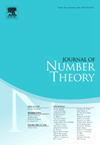具有有界素数间隙的Lucas序列的成员
IF 0.7
3区 数学
Q3 MATHEMATICS
引用次数: 0
摘要
本文研究了所有素数序列中素数因子具有有界间隙指标的Lucas序列的项。我们的一些结果依赖于某些被广泛相信的猜想。在我们的证明中,我们结合了各种工具,包括Baker的方法,子空间定理,以及Stewart, Murty和Wong的结果。本文章由计算机程序翻译,如有差异,请以英文原文为准。
On members of Lucas sequences with bounded prime gaps
In this paper, we look at terms of Lucas sequences whose prime factors have indices with bounded gaps in the sequence of all prime numbers. Some of our results depend on certain widely believed conjectures. In our proofs we combine various tools, including Baker's method, the subspace theorem, and results of Stewart, and Murty and Wong.
求助全文
通过发布文献求助,成功后即可免费获取论文全文。
去求助
来源期刊

Journal of Number Theory
数学-数学
CiteScore
1.30
自引率
14.30%
发文量
122
审稿时长
16 weeks
期刊介绍:
The Journal of Number Theory (JNT) features selected research articles that represent the broad spectrum of interest in contemporary number theory and allied areas. A valuable resource for mathematicians, the journal provides an international forum for the publication of original research in this field.
The Journal of Number Theory is encouraging submissions of quality, long articles where most or all of the technical details are included. The journal now considers and welcomes also papers in Computational Number Theory.
Starting in May 2019, JNT will have a new format with 3 sections:
JNT Prime targets (possibly very long with complete proofs) high impact papers. Articles published in this section will be granted 1 year promotional open access.
JNT General Section is for shorter papers. We particularly encourage submission from junior researchers. Every attempt will be made to expedite the review process for such submissions.
Computational JNT . This section aims to provide a forum to disseminate contributions which make significant use of computer calculations to derive novel number theoretic results. There will be an online repository where supplementary codes and data can be stored.
 求助内容:
求助内容: 应助结果提醒方式:
应助结果提醒方式:


